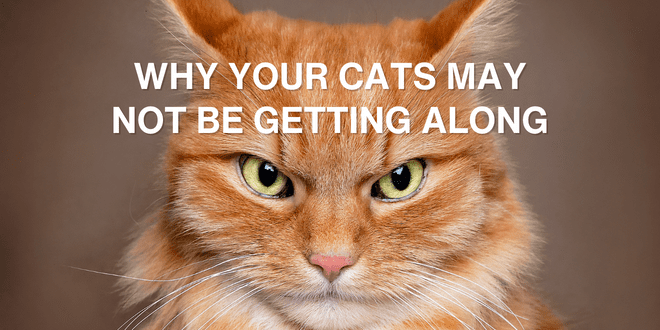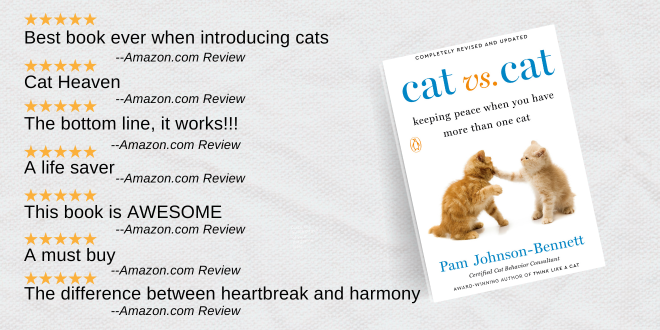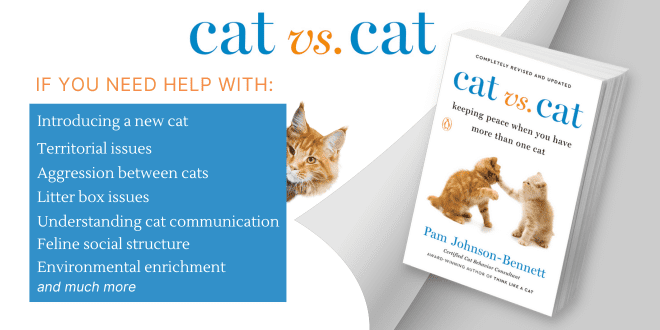
Listen to the audio version of this article
Have you ever wondered why your two cats don’t get along and yet your neighbor’s four cats all live in harmony? Many cat parents live in households with more than one cat and there are no issues, but for others, tension is ongoing. What causes some cats to simply not get along? And, could you be missing some subtle signs that indicate all is not peaceful between your cats?
There’s a very long list of reasons why the cats in your home may not get along, including lack of socialization, poorly done socialization, medical issues and so much more. From what I see during many of my in-home visits though, the most common reasons are:
How the environment is set up
The cat parent’s lack of awareness regarding subtle signs of conflict
Number and Placement of Resources for Your Cats
Even though cats are social animals, it’s their nature to hunt alone. They don’t hunt in packs and the prey they pursue is small – enough for one meal. Even if your indoor cat doesn’t engage in outdoor hunting, he’s hardwired to be protective of his resources. Some cats are more concerned with the protection of their resources than others.
Conflict Between Cats Bubbling Below the Surface
The social interaction between your cats tends to go smoothly when everyone feels they don’t have to compete for food, safe places to eliminate and safe napping areas. In many households though, I see cats put in an environment where there’s ongoing competition for resources and not enough personal space. The tension and conflict between the cats may be subtle enough that the cat parents don’t even notice or they misinterpret it until the situation gets to the point where one cat starts spending more time alone or all-out war is declared with fur flying and banshee screams. You may have not realized the subtle signs of conflict during mealtime as one cat consistently backs off when the other cat enters the room. You may not have paid much attention during playtime to how one cat is the main participant when you get out a single interactive toy for both cats. Or maybe you’ve just gotten used to the fact that one cat claims your bed at night and won’t let the other cat up there.
A timid cat might take to hiding under the bed or skulking around the house in order to access resources when the coast is clear. He may even begin to display sickness behaviors from the ongoing stress (such as decreased appetite, elimination out of the litter box, vomiting, diarrhea, etc). A more assertive cat may engage in resource guarding. He might intimidate another cat away from the feeding station, favored sleeping areas, toys or he may lounge in the pathway to the litter box in order to prevent another cat from being able to enter. This behavior could be so subtle that you don’t see it or it could be outright where there’s growling, hissing, body language signals or actual fighting between the cats. The outright aggression is the one cat parents notice but sadly, it’s the conflict that just bubbles under the surface that can go on for years without being addressed.
Tension between your cats can also occur if attention is paid to one cat more than the other or it seems as if one cat is favored. Cats don’t misbehave out of spite but when a cat parent interprets it that way and spanks, yells or squirts water at one cat for a perceived infraction, it doesn’t help the feline relationships. A cat getting intimidated by another cat may have resorted to eliminating outside of the litter box due to fear. If the cat parent yells or punishes the cat for the perceived misbehavior it just escalates an already stressful situation for the cat.
The Cats’ Environment
Cat parents want their cats to live as part of a happy family but many times they don’t take into consideration how the cat’s nature plays into the need for resource security. You may want your cats to share one community food bowl in the kitchen or share one big litter box in the laundry room but one or both of those things may be what’s triggering conflict. Much of a cat’s social interaction with other cats has to do with resource availability. Cats live together cooperatively when there are adequate resources for everyone. Competition and conflict occur when there isn’t enough to go around. Even though you’re sure you’ve put enough food in the bowl for both cats, one of the cats may not feel that way. Even though you’ve set up a litter box that’s big enough for two cats, a cat of lower status may not feel comfortable enough entering the territory of the higher ranking cat.
Ensure There’s Enough for Everyone in Your Cat Family
Resource security is important to cats. Watch for subtle signs of tension you may have previously overlooked. The solution, in many cases, is simply to increase the number and location of resources. Your cats may feel more secure if you increase the number of feeding stations. In some cases that may just involve giving each cat a separate bowl. In other cases you may have to set up feeding stations in multiple locations. When it comes to the litter box, instead of having one toileting area, set up boxes in multiple locations. This way, one cat is never forced to cross another cat’s path. For playtime, always make time in your schedule for individual interactive play sessions. If doing group play, have another family member focus on the other cat or if you’re by yourself, hold a fishing pole toy in each hand so no one has to compete.
Divide your attention equally among the cats. Even if you’re mad at one cat because you think he’s being a bully or you’re upset at the cat who peed on the carpet, don’t show favorites. Your attention and love are also cherished resources to your cats and they shouldn’t have to compete for those.
Vertical Territory
The more vertical territory you can create in the home, the better for everyone. A cat of higher status typically prefers to perch in the highest location. A timid cat may also choose an elevated spot for safety and for maximum visual warning time to see approaching opponents. If you don’t have vertical territory, cats may compete for the spot on top of your refrigerator or high atop the bookcase. Provide cat trees, window perches, and if possible, a few cat shelves to increase vertical territory. It’s a great way to increase the size of your feline environment without having to add onto your home. We live in a horizontal world but cats live in a multi-leveled vertical world. Just the addition of some safe cat shelving may lower the tension in your home by a significant amount.
When creating cat shelves, just make sure you create more than one escape route so no one ever feels trapped. Conflict happens when cats feel back in a corner with no way out. When it comes to a potential threat and the fight or flight response, cats would much prefer to get the heck out of there rather than do battle.
Address Potential Cat Behavior Problems Right Away
If you notice even a hint of there being an issue between your cats, address it right away before it becomes a major stress trigger. Whether it’s a stare-down at the food bowl or one cat following the other to the litter box in order to intimidate, modify the environment so no one has to compete and modify your own behavior to create security and peace between all family members.
Disagreements between your cats are bound to happen from time to time but if you set up the environment with more than enough resource availability and security, you’ll greatly reduce the chances of competition and conflict.
Need More Information?
For more specifics on maintaining peace in a multicat environment, check out the revised and updated edition of Cat vs. Cat by Pam Johnson-Bennett. Pam’s books are available at bookstores and online. We’ve included links to Amazon here on our website.
If you have a question regarding your cat’s health, please contact your veterinarian. This article is not intended as a replacement for your cat’s veterinary care.




